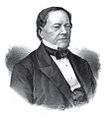Template:Selected anniversaries/May 22: Difference between revisions
No edit summary |
No edit summary |
||
| Line 50: | Line 50: | ||
||1933: Chen Jingrun born ... mathematician who made significant contributions to number theory. Pic. | ||1933: Chen Jingrun born ... mathematician who made significant contributions to number theory. Pic. | ||
||1936: George H. Heilmeier born ... engineer ... LCD. | ||1936: George H. Heilmeier born ... engineer ... LCD. Pic. | ||
||1942: Ted Kaczynski born ... academic and mathematician turned anarchist and serial murderer (Unabomber). | ||1942: Ted Kaczynski born ... academic and mathematician turned anarchist and serial murderer (Unabomber). Pic. | ||
||1943: Joseph Stalin disbands the Comintern. Pic. | ||1943: Joseph Stalin disbands the Comintern. Pic. | ||
| Line 58: | Line 58: | ||
File:WAC Corporal rocket at White Sands.jpg|link=WAC Corporal (nonfiction)|1946: The [[WAC Corporal (nonfiction)|WAC Corporal]] becomes the first US rocket to reach edge of space. | File:WAC Corporal rocket at White Sands.jpg|link=WAC Corporal (nonfiction)|1946: The [[WAC Corporal (nonfiction)|WAC Corporal]] becomes the first US rocket to reach edge of space. | ||
||1956: Walther Ludwig Julius Kossel dies ... physicist known for his theory of the chemical bond (ionic bond/octet rule), Sommerfeld–Kossel displacement law of atomic spectra, the Kossel-Stranski model for crystal growth, and the Kossel effect. | ||1956: Walther Ludwig Julius Kossel dies ... physicist known for his theory of the chemical bond (ionic bond/octet rule), Sommerfeld–Kossel displacement law of atomic spectra, the Kossel-Stranski model for crystal growth, and the Kossel effect. Pic. | ||
||1968: The nuclear-powered submarine the USS Scorpion sinks with 99 men aboard, 400 miles southwest of the Azores. | ||1968: The nuclear-powered submarine the USS ''Scorpion'' sinks with 99 men aboard, 400 miles southwest of the Azores. | ||
||1969: Apollo 10's lunar module flies within 8.4 nautical miles (16 km) of the moon's surface. | ||1969: Apollo 10's lunar module flies within 8.4 nautical miles (16 km) of the moon's surface. | ||
||1974: Irmgard Flügge-Lotz dies ... mathematician and aerospace engineer. | ||1974: Irmgard Flügge-Lotz dies ... mathematician and aerospace engineer. Pic. | ||
||1983: Albert Claude dies ... biologist and academic, Nobel Prize laureate. | ||1983: Albert Claude dies ... biologist and academic, Nobel Prize laureate. | ||
Revision as of 14:35, 21 May 2019
1592: Giordano Bruno arrested. Among the numerous charges of blasphemy and heresy brought against him is his belief in the plurality of worlds.
1873: Lawyer, translator, and inventor Per Georg Scheutz born. He will invent the Scheutzian calculation engine, based on Charles Babbage's difference engine.
1895: Mineralogist, physicist, and mathematician, and crime-fighter Franz Ernst Neumann uses what is now known as Neumann's Law (the molecular heat of a compound is equal to the sum of the atomic heats of its constituents) to detect and prevent crimes against chemistry.
1930: Mathematician, academic, and rabbi Eliezer 'Leon' Ehrenpreis born. He will prove the Malgrange–Ehrenpreis theorem, the fundamental theorem about differential operators with constant coefficients.
1946: The WAC Corporal becomes the first US rocket to reach edge of space.
2010: Mathematics and science writer Martin Gardner dies. His interests included stage magic, scientific skepticism, philosophy, religion, and literature.





